Equi-note 36 Horseshoeing-clip problems


Horseshoeing-clip problems
Why are clips needed?
Clips are raised portions of the shoe made at different locations around its frontal perimeter. According to American Farriers Journal, a number of farriers/blacksmiths justify them for the following reasons: That they:
Reinforce the nail work
Reduce slippage/twisting of the shoe during shoeing
Stabilize a rolled/rockered toe on the shoe
Stabilize a shoe on an uneven bearing surface
Support a weak or injured hoof
However, the majority of these points are the consequence of shoeing deficiencies. The only really valid one refers to the weak or injured hoof. A subsequent post will review them in detail.
They can play a positive role in increasing the shoe’s resistance to the effects of torque or twisting created by the leg’s action against the ground. This action can contribute to weakening the hold of the nails. However, it needs to be made clear that the risk of losing a shoe is increased if the bearing surface of the hoof is uneven, if the shoe is crooked or if it is poorly fitted. These are farrier/blacksmith originated problems and should not be used as arguments justifying the need for clips.
The next photo shows the effect of the twisting action because it makes a deeper cut in the ground. This effect is made by the hind hoof as it moves into and out of the horse’s mid-line and back to a straight arc described by the hip joint. The hind hoof is at the top and has over-tracked the front hoof.
This photo may explain why there has traditionally been a greater need for clips on the hind hooves. However, it does not justify their use on the front hooves.
Hind hoof twists more against the ground than the front
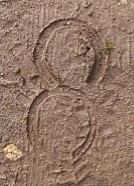
Evolution of side clips
Criticism made of side clips in this post are mainly directed to their lateral lameness effect. Research showed that this occurred mainly on the horse’s front hooves. This shoeing style is of more recent origin compared to single toe clips on the front hooves.
In terms of timing, Seamus Brady is credited with establishing the side clip (also referred to as a quarter clip which is slightly further forward) as a standard practice for hunters and jumpers in North America through his long-term work with the U.S. Olympic team. He started using side clips on these high-level horses in the 1960s. (American Farriers Journal, Toe Clips Vs. Side Clips, 2003)
Side clips on the hind hooves have been used for much longer and were considered more justifiable by farriers/blacksmiths given the hind hoof’s narrower shape, its role in the generation of propulsion, and its twisting action.
Butler Professional Farrier School writes in “Horseshoe Clips” in 2019 as follows: “Horseshoe clips have been used for many years. Historically, toe center clips are believed have been introduced between 1825—1830 in England by H. Hallen. William Youatt wrote in 1831 that “clips are necessary on all heavy horses.” As Youatt indicated, clips became very popular on heavy “draught” (draft) horses in the early 1800s due to the heavy plodding gait of the work animals. Clips came “into fashion” on riding horses a little later (Ivan Sparkes, Old Horseshoes, 1976).
Where do clips cause front hoof soreness?
During lateral work there are four specific locations on the hooves where the horse will reveal soreness generated by side clips: on the inside or outside quarter of either of the hooves. These same four locations apply to both front and hind hooves. The location of this pressure is shown in the next image on the outside quarter of the near-fore hoof and the inside quarter of the off-hind hoof.
Ground pressure is maximised on the quarters of the hooves
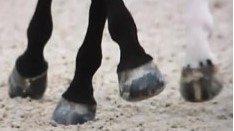
This condition is particularly visible when the horse is performing lateral work. This is because at this instant maximum body weight is placed at the exact location of the side clip.
Side clip soreness on front hoof
An example of soreness caused by a clip pinching the front hoof’s quarter is shown next. This compares a sound vs an unsound horse. Both horses are performing a half-pass to the right.
As is to be expected with a lame horse, the horse limped every time it leaned sideways; since at this moment the horse was putting pressure on the sore part of its hoof.
Sound horse-stretch Unsound horse-no stretch
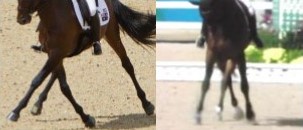
While the pain generated by side clips can be very evident with the front hooves, it can also affect the back, as shown next.
Clip soreness on hind hoof
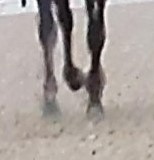
The above photo shows a seriously distorted off-hind leg swing. It is caused by a wrongly placed and wrongly shaped clip on the inside branch of the off-hind shoe. This shoeing mistake created sufficient pain such that the horse showed its discomfort both in the front-back leg swing as well as in the lateral work. This meant that the horse was showing an almost continuous unsoundness. As can be expected, the horse did not perform well. It is disappointing to note that this horse is from one of the leading European dressage nations.
Intensity of the soreness
The intensity of the soreness is highly variable. It may be different from one front hoof to another; it may be different on the inside compared to the outside of the hoof. Pain can range all the way from mild discomfort to severe lameness.
Pain will diminish as more time elapses since the horse’s last shoeing. Much of the clip pain will disappear in about one week. This is because the previously sensitive white line hoof material becomes more desensitized as the hoof grows. This process can be technically termed the transition from dermal/vascular to epidermal/horny matter. Hoof growth and the removal of pain caused by a sore hoof wall provides a convenient explanation for farriers/blacksmiths to use to evade their responsibility in its creation.
There is a key reason why the horse is susceptible to unsoundness at the position of the clip. This is because there is a very small location along the quarter of the hoof where both the side clip and two or three nails are placed.
This section of the hoof wall along the quarter is both thin and almost vertical. The hoof wall is much thinner near the quarter than at the toe. This requires great accuracy in nail placement by the farrier/blacksmith. A slight variation in the nail’s placement means that it can penetrate the sensitive portion of the hoof wall.
An example of a side clip and three nails is shown next.
Three nails and side clip are very close together
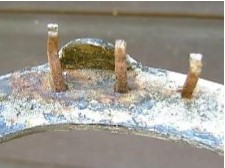
Causes of side clip soreness
The pain from the side clips can be the consequence of various actions:
Poor quality preparation of clip
Poor quality fit of clip into hoof
Misfit between hoof cut-out and clip
Cut-out too deep into the white line
Twisted shoe/clip causing unequal mediolateral hoof pressure
An excessive number of nails too close to the clip
Too large nails too close to the clip
Nails that have been excessively tightened too close to the clip
Excessively harsh hammering to seat the clip and clenches into the hoof wall
Too aggressive burning of shoe and clip into hoof
International clip originated problems
An important question to ask is whether these clip problems are generalized or whether they are located in particular countries or regions. The following photos indicate that the problem is generalized.
Comments are included to indicate some of the effects they may cause. These examples show horses at the top of their competitive careers.
Clip problems
Defective clips-risks lameness/interference
Spain Sweden
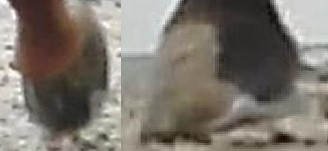
The clip on the Spanish hoof is too large and exposed, as is the rim of the shoe towards the heel, which risks interference.
The clip on the Swedish horse has a poor shape and has been poorly prepared. When the clip was raised, the branch of the shoe beneath it was distorted creating an uneven bearing surface. This obviously unbalances the horse. The heel of the shoe has been thickened. This has been done to compensate for the fact that the toe of the hoof has not been properly trimmed by the farrier/blacksmith. As can be seen, the toe is far too long and hangs over the toe of the shoe. This has created a too low angle of hoof which the thickened heel tried to correct.
Mismatched toe and shoe-imbalance/slippage
Spain Australia
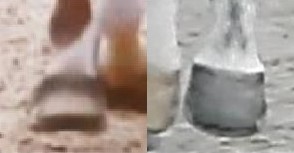
The above shoes rely on clips for stability in part to compensate for incorrectly prepared bearing surfaces. However, the two shoes are different.
In the case of the Spanish horse the toe of the shoe is set back away from the toe of the hoof. While this may have been done for the purpose of improving break-over it has created another problem. This is now a double toe. This means that at the moment when the hoof leaves the ground there is no single defined point of final push. This is usually the leading edge of the shoe. However, in this case it is now somewhere between the rim of the shoe and the rim of the hoof, as the next photo shows. This dispersion weakens the leg’s thrust by changing and broadening its location.
Double toe
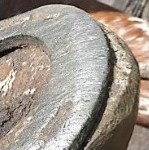
In the case of the Australian hoof, there is a different problem. While the clips are of a correct size and location, there is a poorly prepared bearing surface of the toe of the hoof. This will both unbalance the hoof while increasing the risk of shoe loss due to ground friction and the effect of shearing.
Back shoes on front hooves-imbalance and pinching
Brazil
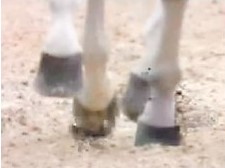
In addition to the fundamental problem of the reversal of the shoes, there are others. The shape of this front hoof capsule seems to have a shortened toe and a narrow quarter. This may be the consequence of the farrier’s/blacksmith’s adapting the hoof’s shape to that of the hind shoe.
There are further problems. There are issues with clip size (too big) and placement (too far to the front), which lead to imbalance and pinching. The hoof capsule size is too small (this can have multiple causes, including conformation, injury or excessive rasping), and square toe (probably dubbed). There is also likely to be an increased risk of interference from the toe clip on a longer hind hoof.
